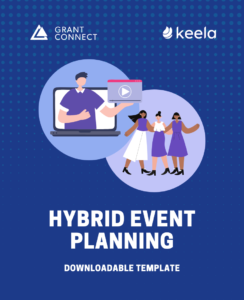A Timeline to Ace your Nonprofit Fundraising Event Planning


So, you’ve been tasked with throwing a fundraising event for your nonprofit organization.
Immediately, ideas and panic start flooding your brain in equal measure. A yard-sale? A golf tournament? A Gwyneth Paltrow-hosted, a black-tie event with a guest appearance from Michelle and Barack Obama?
Above all, you need to be thinking about what will bring in the most amount of money, right?
Actually, not so much. Unfortunately, it’s easy to think about hosting a fundraising event as you would approach a warehouse closing down sale, where the goal is to grab up as much money as you can through ticket sales and donations in a mad dash towards the end of the day.
However, this approach leaves a lot to be desired both for your organization and your supporters. Yes, your organization needs to raise money, and yes fundraising events can be an incredibly successful way of getting it.
Not because the multi-billionaires of the world are going to turn up and hand it over on the night whilst Jennifer Garner makes a tearful speech, but because they create an amazing opportunity for you to meet, connect with, and form strong, lasting relationships with your supporters.
Here, we’ll lay out a timeline of what steps to take in the months, weeks, and days leading up to, and following your event.
4-6 Months Before Your Nonprofit Fundraising Event
Remember, the more planning and logistics you get out of the way ahead of time, the easier hosting an event will be. Then you can focus your energy on connecting with your community.
To note, the exact timeline of your event will depend on the scale and type of event you choose. A formal black-tie event with several hundred guests may require a year of planning, versus a casual trivia night at your local community center that could come together in a couple of months.
1. Solidify the purpose of your event
Firstly, you need to make sure you have a clear goal for throwing the event. Why has your organization decided to host a fundraising event now? Your purpose may be to reach a specific fundraising goal, or it may be to raise awareness and engage personally with your supporters.
Once you’re clear on the purpose, it’s important to set goals that you can track and measure in order to understand if the event was a success or not, and worth spending your organization’s resources on again.
2. Decide on the type of event you want to host
This is going to depend on your organization and the community you want to attract and build long-term relationships with. What kind of event would they want to attend? Young, active 20-30-year-olds interested in supporting a health initiative may be far more interested in attending a fun run than a fancy gala.
If one of the main goals of your fundraising event is to grow your support base and connect to long-term donors, knowing what your target attendees want, and having that fit with your organization’s mission, is important when planning.
3. Organize your event team
A successful fundraising event hinges on having great people to help run it. Put together your team for planning, hosting, and doing any follow-up work on the event. Your team can consist of staff, volunteers, and board members: whoever is available to commit to the timeline.
Example team members may include:
- A team lead
- Someone in charge of technology and software
- A vendor coordinator
- A host
- A crew to collect and log donations
- Someone in charge of marketing
- Someone in charge of finance, and any other roles your particular event might need.
4. Plan out your fundraising efforts
Incorporate your event into your overall fundraising calendar and decide on a date. You’ll want to take the availability of your team into account and avoid clashes with any other major events that might draw focus from your target attendees. Be flexible on the time of day or day of the week in order to save cost but keep the time of year consistent if it is an annual event.
Design your budget, including every foreseeable need, estimated costs, and quantities. Make sure to include a little padding for any unforeseen costs.
Then it’s time to decide on the number of guests you want and get ready to sell tickets. Your ticket prices should be aligned with your goals and budget. If you’re worried about projections, offering early bird pricing will allow you to lock in numbers early on.
5. Identify your target audience
Compile a list of target attendees. If you have a CRM system, data you already have could help greatly in identifying your ideal audience.
Choose a theme that your target community would relate to, and decide on relevant activities to include in the schedule such as a raffle or silent auction. By this point, you should also decide on entertainment and a host.
6. Choose your event venue, sponsors, and suppliers
Take into account its size, location, cost, and appropriateness for your event. If you are building a strong community that aligns with that of the venue you may even be able to ask for a discount or possible sponsorship.
On the topic of sponsors, now is the time to approach companies and individuals that you believe would strongly align to your mission and event, and ask them to sponsor prizes, auction items, or any event-related items such as decorations, catering, entertainment, or equipment.
Book any equipment you’ll need, such as microphones, speakers, cameras, etc, and decide on which software will best serve you. The right software can help with task management, receiving and tracking donations, ticketing, finding your target attendees, and logging and analyzing feedback on the event.
Select your caterer if you need one, and decide on a menu, taking into account varying dietary requirements.
Finally, check for any legal requirements or documentation that you may need to submit well ahead of time such as any special licenses or health and safety approval to ensure everything goes off without a hitch.
7. Start to market your event
Put together your marketing plan for the event. Be clear on the story you want to tell, and the narrative you use to get your message across. This is critical in reaching the target audience you want to attract to form your long-term community.
Nothing makes spreading the word easier than good branding. Decide on a set color palette, and create hashtags and a logo that you can imprint on all of your materials, including invitations, programs, banners, posters, flyers, and any other materials. To simplify the process, there are multiple tools available, such as flyer making tools, which can help you create amazing flyers.
You can print out flyers to display or hand out in locations where your target audience regularly congregates. And if you want to advertise your event without unnecessary printing, you can take to social media. Use Twitter, Instagram, and Facebook to promote your event and encourage sharing.
It should appear on your organization’s website, with the ability to sell tickets online. You can include a description of the event and its purpose in your regular newsletters. Consider including a banner advertising the event in your email campaigns. If appropriate, prepare a press release for local media outlets.


Learn 10 Key Steps You Need to Take to Run a Successful Virtual Fundraiser.
Use this guide to prepare your team and learn about the tools you need to ensure your next online fundraiser is your best yet.
1-2 Months Before Your Nonprofit Fundraising Event
Now that the bulk of the planning is out of the way, it’s time to get down to the details.
Plan your schedule for the event, including a specific and detailed timeline. You should check in with your vendors to ensure everything is on track, as well as finalize your sponsor names and add them to the program.
it’s also time to personalize your invitations and get them in the mail. Make sure they are in line with your theme, and send them in a format that can be easily incorporated into your marketing plan.
Event Checklist – 2 Weeks Before Your Nonprofit Fundraising Event
- With your menus, programs, flyers, and other materials finalized, it’s time to get them printed. Make sure you’ve included your hashtags and social media links on everything in order to best promote your event.
- If you need one, create your seating chart, and check that you have all the names for each place.
- Send your final headcount to the venue and your caterers, making note of any accessibility needs or dietary issues that you’re aware of.
- Finalize all your presentation materials, making sure you have received any additional presentations from your sponsors, host, or other participants.
- Conduct an inspection of the venue, equipment, and software that you will be using.
- Confirm the event’s schedule with your team, assigning specific duties and responsibilities to each team member, leaving room for backups in case anyone is sick or unable to make it on the day.
- Prepare all your vendor payments and deposits.
Event Checklist – 1 Day Before Your Nonprofit Fundraising Event
- Set up everything in the venue as much as they will allow, and to the extent that important equipment will be kept safe and untouched.
- Prepare all supplies that you will need on the day, clustering them according to teams or stations where they will be needed.
- Check in with your team so that everyone understands what time to be there, what their duties will be on the day, and that they are committed to being there.
Event Checklist – On the Day of Your Nonprofit Fundraising Event
- Have your team arrive before all your vendors, with your team lead arriving first so that the day begins in an orderly fashion.
- Get your check-in and check-out tables set up with whatever equipment and software you need. Make sure you keep tables with expensive equipment or sensitive information staffed at all times.
- Complete any last-minute setup.
- Do a complete walk-through, as if you were an attendee arriving and moving through the event, checking all equipment and software as you do so.
- Follow your schedule for the day, not panicking if things don’t work out perfectly. They almost never do!
- Remind your attendees about your various social media hashtags, and to take plenty of pictures and add live comments.
- Remember to take pictures and upload comments yourself. Hav
- Have your team engage with attendees as the event progresses. Strike up conversations, ask how they’re enjoying it, and what brought them to the event. You will be able to gather an enormous amount of information on your donors and potential donors by using this opportunity to speak directly with them and get to know them. Make sure to take note of what you’ve learned after each conversation (not during!) and add it to your CRM.
- Ensure everyone has cleared out of the venue and that vendors have taken their equipment with them.
- Keep everything that you borrowed or that needs to be returned packed safely away and kept separate from any junk to be thrown out as you clean up the venue.
What to Discuss After Your Nonprofit Fundraising Event
Congratulations! Your event was a success. However, the work isn’t over for you just yet. There are a few follow-up items that you need to check off your list.
- First and foremost, send personalized thank you notes to your attendees, donors, and sponsors, and don’t forget your team! Ensure you’ve included tax-deductible information where necessary and relevant.
- Return all borrowed equipment, and make sure your vendors have been paid in full.
- Fill in actual costs to your budget that you prepared at the start.
- Compile and evaluate all the feedback you received on the night. If you feel you need more feedback, consider sending a survey to your attendees asking what they enjoyed, what they would have changed, if they faced any particular issues (such as accessibility), or any other feedback they would like to share.
- Compile demographic data on your attendees and generate a report for analysis.
- Make a decision as to whether this event should be included again in your future fundraising strategy.
- Incorporate the relationship building you achieved on the night into your overall stewardship plan.
Most importantly, remember to take the time to enjoy the event. It is rare that we have the opportunity to engage with donors, volunteers, supporters, the board, and the broader community in such a personal, face-to-face medium.



